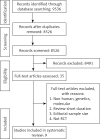Omega-6 fatty acids and the risk of cardiovascular disease: insights from a systematic review and meta-analysis of randomized controlled trials and a Mendelian randomization study
- PMID: 35316920
- PMCID: PMC8924827
- DOI: 10.5114/aoms/136070
Omega-6 fatty acids and the risk of cardiovascular disease: insights from a systematic review and meta-analysis of randomized controlled trials and a Mendelian randomization study
Abstract
Introduction: Omega-6 polyunsaturated fatty acids (PUFAs) represent almost 15% of the total energy intake in Western countries. Their effects on the cardiovascular (CV) risk factors are still controversial. Thus, we performed a systematic review and meta-analysis of randomized control trials (RCTs) as well as a Mendelian randomization (MR) analysis to evaluate the links and possible causality between supplementation or serum levels of omega-6 PUFA, CV disease (CVD) and cardiometabolic risk factors.
Material and methods: Selected databases were searched until September 2019 to identify prospective studies investigating the effects of omega-6 PUFA supplementation on CVD events/mortality. Random-effects model meta-analysis was performed for quantitative data synthesis. Trial sequential analysis (TSA) was used to evaluate the optimal sample size to detect a 20% reduction in outcomes after administration of omega-6 PUFAs. The inverse variance weighted (IVW) method, weighted median-based method, MR-Egger and MR-Pleiotropy RESidual Sum and Outlier (PRESSO) were applied for MR.
Results: The pooled estimate risk ratio (RR) of omega-6 PUFA supplementation was 0.94 for any CVD event (95% CI: 0.77-1.15, I 2 = 66.2%), 1.06 for CVD death (95% CI: 0.73-1.55, I 2 = 66.2%), 0.84 for coronary heart disease (CHD) events (95% CI: 0.61-1.16, I 2 = 79.4%), 0.87 for myocardial infarction (MI) (95% CI: 0.74-1.01, I 2 = 2.3%) and 1.36 for stroke (95% CI: 0.45-4.07, I 2 = 55.3%). In contrast, MR showed that individuals with higher serum omega-6 acid - adrenic acid (AA) levels had a greater risk for CHD events (IVW β = 0.526), MI (IVW β = 0.606) and large artery stroke (IVW β = 1.694), as well as increased levels of fasting blood glucose (FBG) (IVW β = 0.417), low-density lipoprotein cholesterol (LDL-C) (IVW β = 0.806), high-density lipoprotein cholesterol (HDL-C) (IVW β = 0.820), and lower levels of triglycerides (TG) (IVW β = -1.064) and total cholesterol (TC) (IVW β = -1.064).
Conclusions: Omega-6 PUFA supplementation did not affect the risk for CVD morbidity and mortality. Additionally, based on MR analysis we found that higher AA levels might even significantly increase the risk of CHD, MI and large artery stroke, as well as the levels of FBG and LDL-C, whereas they were negatively associated with TC and TG. Since a considerable chance of heterogeneity was observed for some of the results, further research is needed to elucidate the effects of omega-6 PUFAs on cardiometabolic outcomes.
Keywords: Mendelian randomization; cardiovascular disease; cardiovascular mortality; coronary heart disease; meta-analysis; omega-6 polyunsaturated fatty acids; stroke.
Copyright: © 2022 Termedia & Banach.
Conflict of interest statement
NK has given talks, attended conferences and participated in trials sponsored by Angelini, Astra Zeneca, Bausch Health, Boehringer Ingelheim, Elpen, Mylan, NovoNordisk, Sanofi and Servier. All other authors have nothing to declare.
Figures







Similar articles
-
Genetically Higher Level of Mannose Has No Impact on Cardiometabolic Risk Factors: Insight from Mendelian Randomization.Nutrients. 2021 Jul 27;13(8):2563. doi: 10.3390/nu13082563. Nutrients. 2021. PMID: 34444725 Free PMC article.
-
Monounsaturated Fatty Acid Levels May Not Affect Cardiovascular Events: Results From a Mendelian Randomization Analysis.Front Nutr. 2020 Sep 2;7:123. doi: 10.3389/fnut.2020.00123. eCollection 2020. Front Nutr. 2020. PMID: 32984395 Free PMC article.
-
Omega-3 Fatty Acids and Cardiovascular Disease: An Updated Systematic Review.Evid Rep Technol Assess (Full Rep). 2016 Aug;(223):1-1252. doi: 10.23970/AHRQEPCERTA223. Evid Rep Technol Assess (Full Rep). 2016. PMID: 30307737
-
Exploring the causal pathway from omega-6 levels to coronary heart disease: A network Mendelian randomization study.Nutr Metab Cardiovasc Dis. 2020 Feb 10;30(2):233-240. doi: 10.1016/j.numecd.2019.09.013. Epub 2019 Sep 16. Nutr Metab Cardiovasc Dis. 2020. PMID: 31648883
-
Causal associations between polyunsaturated fatty acids and kidney function: A bidirectional Mendelian randomization study.Am J Clin Nutr. 2023 Jan;117(1):199-206. doi: 10.1016/j.ajcnut.2022.11.010. Epub 2022 Dec 19. Am J Clin Nutr. 2023. PMID: 36789939
Cited by
-
Lipidomic Signature of Healthy Diet Adherence and Its Association with Cardiometabolic Risk in American Adults.Nutrients. 2024 Nov 22;16(23):3995. doi: 10.3390/nu16233995. Nutrients. 2024. PMID: 39683389 Free PMC article.
-
Adrenic acid: A promising biomarker and therapeutic target (Review).Int J Mol Med. 2025 Feb;55(2):20. doi: 10.3892/ijmm.2024.5461. Epub 2024 Nov 22. Int J Mol Med. 2025. PMID: 39575474 Free PMC article. Review.
-
Polyunsaturated fatty acids and diabetic microvascular complications: a Mendelian randomization study.Front Endocrinol (Lausanne). 2024 Aug 7;15:1406382. doi: 10.3389/fendo.2024.1406382. eCollection 2024. Front Endocrinol (Lausanne). 2024. PMID: 39170741 Free PMC article.
-
Association between type 1 diabetes mellitus and esophageal varices: a Mendelian randomization study.Arch Med Sci. 2024 Jul 25;21(2):605-616. doi: 10.5114/aoms/191419. eCollection 2025. Arch Med Sci. 2024. PMID: 40395911 Free PMC article.
-
Dietary and circulating omega-6 fatty acids and their impact on cardiovascular disease, cancer risk, and mortality: a global meta-analysis of 150 cohorts and meta-regression.J Transl Med. 2025 Mar 12;23(1):314. doi: 10.1186/s12967-025-06336-2. J Transl Med. 2025. PMID: 40075437 Free PMC article.
References
-
- Begg S, Vos T, Barker B, Stevenson C, Stanley L, Lopez AD. The burden of disease and injury in Australia 2003. PHE 82. Canberra: AIHW; 2007.
-
- Harris WS, Mozaffarian D, Rimm E, et al. Omega-6 fatty acids and risk for cardiovascular disease: a science advisory from the American Heart Association Nutrition Subcommittee of the Council on Nutrition, Physical Activity, and Metabolism; Council on Cardiovascular Nursing; and Council on Epidemiology and Prevention. Circulation. 2009;119:902–7. - PubMed
-
- Russo GL. Dietary n-6 and n-3 polyunsaturated fatty acids: from biochemistry to clinical implications in cardiovascular prevention. Biochem Pharmacol. 2009;77:937–46. - PubMed
LinkOut - more resources
Full Text Sources
Research Materials
Miscellaneous
